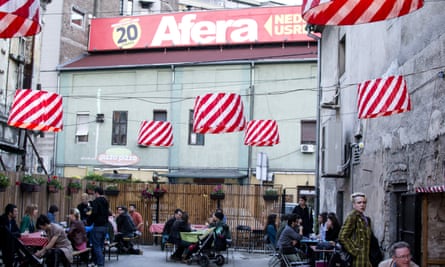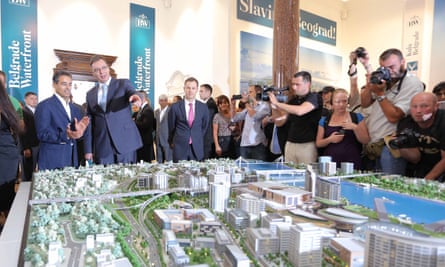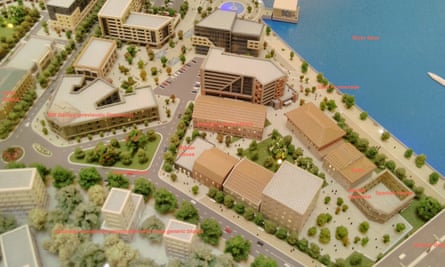The hundreds of Syrians camped out on the green beside Belgrade’s bus station had moved on, headed for the European Union. The only traces of their presence were a row of portable toilets, Arabic notices on a help kiosk and a cordon around some tired-looking grass. But just nearby, a very different Arab arrival is emerging in the Serbian capital.
Belgrade Waterfront is a €3.5bn (£2.5bn) project of condominiums, hotels, offices, retail, parks and paths dominated by a glass skyscraper that will be the tallest between Vienna and Istanbul. Its developer is Abu Dhabi-based Eagle Hills, chaired by Mohamed Alabbar, who previously founded Emaar, builders of the world’s largest shopping mall and tallest building, both in Dubai. Their project manager in Belgrade, Nikola Nedeljkovic, says that “we envisage Belgrade Waterfront to be a game-changing hub for Serbia”, and that it “takes into consideration the balanced sensitivity to nature, culture and modernity”.
Belgrade is painfully divided about the development. Some see a prosperous future in it, others are aghast at the project’s hitherto-alien cityscape, unconvinced of its economic or social benefits and suspicious of Serbia’s relationship with Eagle Hills. There is a dedicated protest movement, whose mascot is an oversized yellow duck. (In Serbian, duck also means dick.)

Belgrade seems an unlikely place for Gulf petrodollars to settle, or for glitzy towers to rise. The Balkan city, where the great Sava and Danube rivers meet, was fought over by Slavs, Greeks, Ottomans and the Austro-Hungarian Empire. It was Tito’s capital of post-war Yugoslavia, then Slobodan Milošević’s Serbian capital, bombed by Nato in 1999. Recently, the gritty city has emerged as an outpost of creative activity and urban cool on the cheap, against the lingering backdrop of socialism. Decaying but defiantly alive, Belgrade is often compared to Berlin after the fall of the Wall.
The ground zero of Belgrade cool is Savamala, a district which slopes down to the river Sava and into Belgrade Waterfront’s site. As well as its hip bars and all-night partying, it became known for its street art, especially along a sidestreet called Mostarska. A block away on busy Karadjordjeva Street, next to the Hotel Bristol – where royalty and Rockefellers once stayed – is one of Serbia’s architectural masterpieces, a heavy 1907 art nouveau block designed by Nikola Nestorović and Andra Stevanović, known as Geozavod because it once housed the Institute of Geophysics. Not so long ago, it was so blackened by pollution that it was hardly visible. But in summer 2014 it re-emerged, impeccably restored and surrounded by blue Belgrade Waterfront banners. Now it is the BW Gallery, and houses the mother of marketing suites.
Climbing its monumental staircase, you enter a baroque hall with marble columns and gold ornamentation, full of light from great windows. The centrepiece, half-filling the room: a vast model of Belgrade Waterfront.
The model shows the entire 1.77 sq km district – a core of dense high-rise buildings, dominated by a glass tower that is twisted in the middle. Called the Kula Beograd, the tower has been designed by the Chicago office of skyscraper architecture titans SOM, and would overlook the River Sava and the new 1.8km Sava Promenade.

Also part of the masterplan is the Balkans’ largest shopping mall, a soap-bubble dome on disused railway land further away from the river. Its 140,000 sq m would make it almost as big as London’s Westfield Stratford. Surrounding the mall would be upwards of 6,000 flats. “We’re trying to focus on the affordable as well as the high-end segments,” Nedeljkovic says. “We’re trying to have a diverse mix of product.” The mix is not obvious in the model. There are offices, of course, and hotels, including a including a swanky W Hotel to open in 2019. Parkland and tree-lined boulevards are spread liberally. Belgrade’s 1884 railway station will become a museum.
This would not be the first time Belgrade has had a vast upgrade in the prevailing urban fashion of the time. From the 1950s, Tito extended Belgrade across the river Sava by creating Novi Beograd, a vast centrally planned grid of brutalist blocks. It includes Genex Tower, currently Serbia’s highest skyscraper. What’s changed since then, worldwide, is a gradual surrender of urban planning to the private sector. Civic masterplans threaded with social ideals have given way to developers’ mixed-use visions promising sustainability and lifestyle – with a waterside dimension if at all possible. Belgrade Waterfront ticks all those boxes.
In fact, the city has actually been wanting to do something like this for a long time. In 2009, architect Daniel Libeskind worked up a plan with Jan Gehl, pioneer of “human-centred urbanism”, for Luka Beograd, a similar project to develop the Danube port area. So when the prime minister, Aleksandar Vučić, unveiled the Belgrade Waterfront scheme in June 2014, it didn’t come as a huge surprise – and the prospect of investment and 20,000 jobs in a country where unemployment hovers at 25% must have seemed like a lottery win. What’s not to like?

When the UAE came to Serbia
The movement Ne da(vi)mo Beograd (a pun that loosely translates as “We won’t let Belgrade d(r)own”) organises street protests against Belgrade Waterfront. They carry yellow ducks and rally behind a gigantic oversized duck the size of a car.
Dobrica Veselinović, one of the movement’s activists, alleges that the agreement to build Belgrade Waterfront is contrary to Serbian law and procedures because he claims that the promenade construction works started without a building permit. He adds: “It does not take into account the needs of society or economic and urban reality in Belgrade.” The group argues that local people were not consulted, that the deal does not provide adequate affordable housing and that it was done in secret.
They also say that families in the area were summarily evicted with mere days’ warning, and their houses demolished. Radio Television of Vojvodina (RTV), a public broadcaster in neighbouring Vojvodina province, ran a report in April interviewing some of the families who said their houses were destroyed without permission. The apartments in which they were resettled were only for limited periods or to buy, according to Veselinović, and “no social service or legal assistance was offered to them”.
Eagle Hills did not respond to queries about the evictions. A public relations spokesperson forwarded a statement that the Belgrade Waterfront agreement is transparent and publicly available, and complied with all applicable laws and regulations. It stated that it received a building permit for Hercegovacka Street leading to the Promenade; as for the embankment reconstruction, it said it had applied for a permit, declaring that the law allowed construction to proceed in the meantime.
The UAE has a strong foothold in Serbia: under an investment deal signed by Vučić when he was minister of defence, the UAE have made agreements with the Serbian defence industry and to secure food supplies, as well buying into Air Serbia. The perceived backroom nature of the Belgrade Waterfront deal has caused real anger.
Balša Božović, the opposition leader in Belgrade’s city assembly, has gone on record calling Belgrade Waterfront the “scam of the century”. He says that Eagle Hills’ total investment will actually be more like €300m, not €3.5bn, and argues that the contract shows that Serbian taxpayers will end up picking up much of the rest of the bill. But support for his DS party has slumped since the post-Milošević times, when the DS ruled a system of crony capitalism; there is a perception that DS represents the “bad old days”, undermining Božović’s complaints. The company did not comment.
On the frontlines in Savamala itself sits Mikser House, a cultural centre with a bar and shop. “We came first as an event [the Mikser festival],” says founder Maja Lalic. “We were parasites.” But as time passed, the Mikser became prime exponents of community participation and projects, and a vital local hub. When the municipality cut down trees nearby, Mikser House organised the response on Facebook and took the protest to city officials; while the annual Mikser Festival solicits citizen engagement in civic issues.

Lalic calls Belgrade Waterfront “a marketing project – actually a PDF brochure of the new city with residences. It all relies on pre-sales.” In London and elsewhere, hardly a week goes by without the “launch” of another unbuilt luxury residential scheme – but residential pre-sales are a model that is relatively new to Serbia. Lalic’s colleague at Mikser, Ivan Kucina, an architecture professor at Belgrade University and the Dessau Institute, says that the pre-sales model has “been appropriated by Arab investors and it’s coming back to Europe ... at the weakest point of Europe”. Belgrade Waterfront’s first major block, a double 20-storey tower called BW Residences, has broken ground. According to Nedeljkovic, 75% of the units have already been sold, to locals, Serbian diaspora and overseas buyers. “Certainly, the international ones are buying for the investment market,” he says.
Milutin Folic, the official city architect, says flatly there will be “no racketeering” involved in Belgrade Waterfront. “All [planning] laws are 100% in line with the EU, and all plans must undergo public display and consultation.” He talks generally about ideas the city has for engaging citizens – neighbourhood workshops, an app for people to report broken pipes and the like, and a plan to give people credits for civic participation that would be redeemable for museum admission, transit tickets or parking tokens. Some of them sound in spirit much like the Mikser’s community initiatives.
Folic is an appointee of mayor Siniša Mali, who was elected in 2014 as an independent. Mali and Folic have reformed the planning committee to build confidence with big investors, who they want to fund ambitious infrastructure projects. The new Chinese-built Pupin bridge has already diverted lorries that thundered through Savamala (though construction traffic is replacing them), as part of long-planned ring-roads, which Folic wants to see happen. His vision is a city-wide jigsaw in which Belgrade Waterfront is just one piece. By converting Prokop station in the south into the city’s new main station, he says that everything “from Belgrade Waterfront to the Pancevo bridge is going to be a green area”. The disused tracks will become “a new park, something like the High Line”. His IME (identity, mobility, environment) blueprint encourages “little projects that make change” and “changes the hierarchy of the traffic”, prioritising pedestrians, then bicycles, public transport, and “at the bottom, the private car”.
Meanwhile, Savamala is changing fast. The cultural venue KC Grad – which opened in 2009 in an abandoned warehouse on Braće Krsmanović, the street running parallel to the river – was the germ of the new Savamala. With all the clubs that sprung up around it, art director Ljudmila Stratimirovic says: “I sometimes feel sorry for what we started – it’s too loud.” But she fears that Belgrade Waterfront will leave her cultural centre with “no meaning”. Nobody from the development has contacted her – and she isn’t even sure if KC Grad lies in the proposed demolition area.
Nearby, little of the street art remains on Mostarka, which is now almost obliterated by demolition, on the very edge of the Belgrade Waterfront site. Businesses like Flash Clean’s carwash look like goners, to be replaced by a seven-storey block. A still-active single rail track separates this cluster from the river and the Sava Promenade. Its wide cycle path – still a novelty in Serbia – features bicycle racks crafted from old rails. There are two wide boardwalks over the river, a colourful new playground and a locally designed Strawberry Smart bench which can charge mobile phones. A new restaurant, Savanova, sits in a smart black block that looks quite Mies van der Rohe, near a cluster of food trucks.
Not all of it is so slick yet. A little further south, pedestrians and cycles share the riverside path with lorries rumbling out of the Belgrade Waterfront site in clouds of dust. Construction is under way for BW Residences. Beyond, a landscape of desolation opens out – broken concrete and rubble, freight wagons, containers being shifted and stacked. Jovan Jelovac, founder of Belgrade Design Week and the man responsible for bringing Libeskind and Gehl together on the shelved Danube plan, describes this area as “a narco-traffic shit-hole [where] you walk down the street and inhale 55 lorries going by”. He says Belgrade Waterfront “is what Belgrade deserves after 20 years of corruption”.
Perhaps he is right. Perhaps the completed Belgrade Waterfront will reflect Jan Gehl’s human-centred ideas, with its promises of pedestrian priority and parks. Perhaps power may shift from developers to grass-roots organisations. In the meantime, Veselinović promises more action and protest from Ne da(vi)mo Beograd: “The big yellow duck is here, getting stronger and bigger!”
Follow Guardian Cities on Twitter and Facebook to join the discussion

Comments (…)
Sign in or create your Guardian account to join the discussion